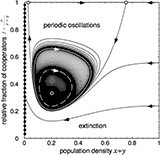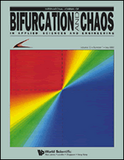Tutorials
Stochastic dynamics in finite populations

Tutorial on the stochastic dynamics arising through demographic noise and mutations in finite populations of size \(N\). Comparisons of the deterministic replicator dynamics in the limit of infinite population sizes \(N\to\infty\) to the stochastic dynamics generated by stochastic differential equations, which are derived from a microscopic description of elementary changes in the population, as well as to results from individual based simulations.
- Traulsen, A., Claussen, J. C. & Hauert, C. (2012) Phys. Rev. E in print.
- Traulsen, A., Claussen, J. C. & Hauert, C. (2006) Phys. Rev. E 74 011901 doi: 10.1103/PhysRevE.74.011901.
- Traulsen, A., Claussen, J. C. & Hauert, C. (2005) Phys. Rev. Lett. 95 238701 doi: 10.1103/PhysRevLett.95.238701.
Evolutionary Games and Population Dynamics

Tutorial on frequency dependent selection in populations of varying size. The classic replicator dynamics assumes constant (infinite) population sizes and thus neglects the ecology of the population. Linking ecological dynamics and evolutionary games generates fascinating and rich dynamical behavior. Most importantly, however, this reveals a new mechanism for maintaining cooperation through negative feedback between population densities and the size of interaction groups.
- Wakano, J. Y. & Hauert, Ch. (2011) J. theor. Biol. 268 30-38 doi: 10.1016/j.jtbi.2010.09.036.
- Wakano, J. Y., Nowak, M. A. & Hauert, Ch. (2009) Proc. Natl. Acad. Sci. USA 106 7910-7914 doi: 10.1073/pnas.0812644106.
- Hauert, Ch., Wakano, J. Y. & Doebeli, M. (2008) Theor. Pop. Biol. 73, 257-263 doi:10.1016/j.tpb.2007.11.007.
- Hauert, C., Holmes, M. & Doebeli, M. (2006) Proc. R. Soc. Lond. B 273, 2565-2570 doi: 10.1098/rspb.2006.3600.
Origin of Cooperators and Defectors

Tutorial on the gradual evolution of distinct cooperative and defective behavioral patterns through evolutionary branching into separate trait groups characterized by high and low cooperative investments. This is based on a model that extends the classical Snowdrift game to continuously varying degrees of cooperation. Apart from evolutionary branching, this model exhibits rich dynamics that can be easily explored using this interactive tutorial.
- Killingback, T., Doebeli, M. & Hauert, Ch. (2010) Biological Theory 5, 3-6 doi: 10.1162/BIOT_a_00019.
- Doebeli, M., Hauert, C. & Killingback, T. (2004) Science 306, 859-862 doi: 10.1126/science.1101456.
2×2 Games

Tutorial on 2×2 games in populations with different structures. 2×2 games describe a rich set of pairwise interactions among individuals. The most prominent game is certainly the Prisoner's Dilemma which has become the paradigm to discuss the emergence of cooperative behavior. If players are arranged on regular lattices, many of these games produce fascinating spatio-temporal patterns. This tutorial provides a hands-on experience of this dynamical world.
- Hauert, C. (2002) Int. J. of Bifurcation & Chaos 12 1531-1548 doi: 10.1142/S0218127402005273.
- Hauert, C. (2001) Proc. R. Soc. Lond. B 268, 761-769 doi: 10.1098/rspb.2000.1424.